Book contents
- Frontmatter
- Dedication
- Contents
- List of contributors
- Preface
- PART I ULTRASOUND PHYSICS, TECHNOLOGY AND HEMODYNAMICS
- PART II CLINICAL CEREBROVASCULAR ULTRASOUND
- (i) Atherosclerosis: pathogenesis, early assessment and follow-up with ultrasound
- (ii) Extracranial cerebrovascular applications
- (iii) Intracranial cerebrovascular applications
- 18 Transcranial Doppler ultrasonography and vasospasm after subarachnoid hemorrhage
- 19 Intracranial cerebral artery stenosis and occlusion
- 20 Arteriovenous malformations
- 21 High intensity transient signals
- 22 Transcranial Doppler monitoring during carotid endarterectomy
- 23 Cerebral vasoreactivity
- 24 Intracranial venous diseases: the role of ultrasound
- PART III NEW AND FUTURE DEVELOPMENTS
- Index
20 - Arteriovenous malformations
from (iii) - Intracranial cerebrovascular applications
Published online by Cambridge University Press: 05 July 2014
- Frontmatter
- Dedication
- Contents
- List of contributors
- Preface
- PART I ULTRASOUND PHYSICS, TECHNOLOGY AND HEMODYNAMICS
- PART II CLINICAL CEREBROVASCULAR ULTRASOUND
- (i) Atherosclerosis: pathogenesis, early assessment and follow-up with ultrasound
- (ii) Extracranial cerebrovascular applications
- (iii) Intracranial cerebrovascular applications
- 18 Transcranial Doppler ultrasonography and vasospasm after subarachnoid hemorrhage
- 19 Intracranial cerebral artery stenosis and occlusion
- 20 Arteriovenous malformations
- 21 High intensity transient signals
- 22 Transcranial Doppler monitoring during carotid endarterectomy
- 23 Cerebral vasoreactivity
- 24 Intracranial venous diseases: the role of ultrasound
- PART III NEW AND FUTURE DEVELOPMENTS
- Index
Summary
Introduction
Arteriovenous malformations (AVMs) are the most commonly recognized of the vascular malformations of the brain because of their clinical and therapeutic implications. Other forms of vascular malformations (e.g. cavernous malformations, telangiectasias, and venous malformations) are not easily visualized on an angiogram or by ultrasonographic means and have only recently gained more attention because the lesions are so readily seen on magnetic resonance angiography.
Morphology
Because of the complex and variable anatomic changes, some understanding of the morphological and physiological aspects of AVMs that may influence the sonographic findings is worth notation. In addition, knowledge of the clinical presentation of AVMs can facilitate the interpretation of the Doppler findings and their changes over time.
AVMs are usually considered to be congenital, but some are fistulas which have the same angiographic appearance and arise from trauma or from venous occlusion. They are composed of a coiled mass of arteries and veins partially separated by thin islands of sclerotic tissue, lying in a bed formed by displacement, rather than by invasion, of normal brain tissue (McCormick & Rosenfield, 1973) (Fig. 20.1). A characteristic histological feature is the absence of capillaries in those assumed to be congenital, a feature not easily estimated by angiographic study alone; (McCormick, 1996; Stein & Wolpert, 1980a, b). Despite a congenital origin, AVMs usually take many years before they become clinically apparent. Some are more biologically active than others, drawing to themselves huge collaterals, while others seem almost dormant.
- Type
- Chapter
- Information
- Cerebrovascular UltrasoundTheory, Practice and Future Developments, pp. 280 - 296Publisher: Cambridge University PressPrint publication year: 2001



